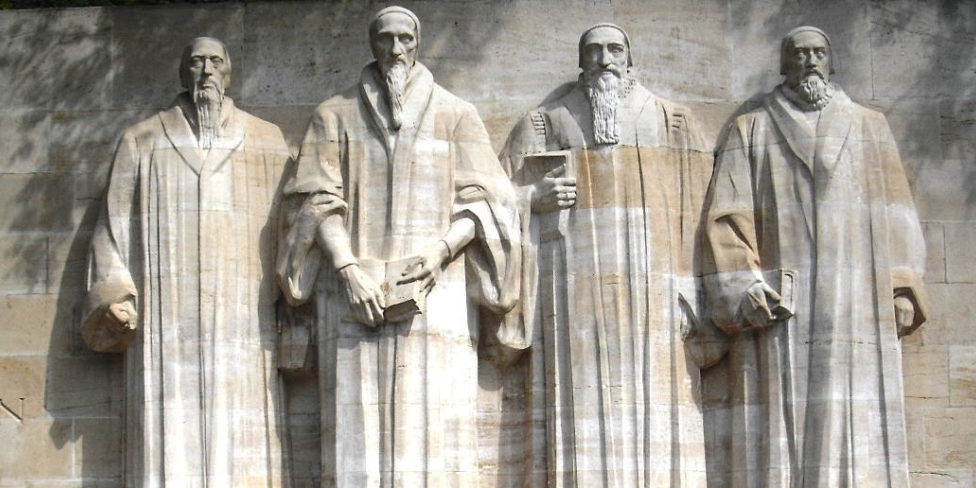
How the Invention of the Printing Press Helped Advance the Reformation
Beginning with the very first generation of believers, God’s people have made use of a number of cultural advancements to fulfill the Great Commission or spark new movements. Perhaps at no other time was this more apparent than in the first century when the good news that Jesus was the resurrected Lord began to spread throughout the Roman world. Astonishingly, a rather inconspicuous group of Jesus’ followers with little resources, political clout, or a message that would have been compelling to most Jews, Greeks, and Romans (1 Cor 1:23), “turned the world upside down (Acts 17:6).”
We should certainly not dismiss the Lord’s providence or the empowerment of the Holy Spirit. However, without overlooking the Lord’s hand upon the church it is also apparent that early Christians were able to benefit from a number of recent cultural developments. Missionaries such as the Apostle Paul were able to make use of an extensive system of roads that were constructed primarily for the benefit of the Roman military, travel freely throughout large territories without fear of local military conflict, a benefit of the Pax Romana, and circulate Christian writings in a language that could be understood by many readers throughout the Greco-Roman world. Beginning with the very first generation of believers, God's people have made use of a number of cultural advancements to fulfill the Great Commission or spark new movements. Click To Tweet
As we consider the developments that took place during the sixteenth century, we find a number of interesting parallels. The religious landscape was much different than in the first century Roman world, of course. Christianity was not a new movement at this point and virtually everyone west of the Ottoman Empire and north of the Mediterranean was associated with Christendom. Yet in this religious and political climate, a number of cultural developments took place which played a significant role in the progression of various reform movements throughout Europe. The migration of a large number of native Greek speakers to Western Europe during the fifteenth and sixteenth centuries certainly played an influential role in prompting fresh study of the Greek New Testament.
As Greek scholars fled West to avoid the invading Ottomans, they brought with them Greek manuscripts and their knowledge of the Greek language to areas where the Bible had only been studied in Latin for centuries. The political climate was also shifting. The papacy was arguably in a weakened state by the early sixteenth century, the result of two previous centuries of division and unrest, and the principle, cuius regio, eius religio, “to whom the reign, to him the religion” began to be applied more broadly in the sixteenth century, allowing local reform movements to take root. It would be difficult to imagine, for example, Luther’s influence without the support and protection of Frederick the Wise or Calvin and Zwingli’s influence without the backing of local councils. The courage and personal sacrifice of those who sought reform during the fifteenth and sixteenth centuries should certainly be acknowledged, though is also evident that a number of cultural changes took place at this time that provided fertile soil for numerous reform movements to bloom throughout western civilization.
The Printing Press as an Instrument for Societal Change
One of the most consequential developments that took place at the dawn of the Reformation era was the invention of the printing press designed by Johannes Gutenberg of Mainz, Germany. Gutenberg was not the first to develop a moveable-type press—this had been around for centuries in Asia—but the particular instrument he developed was greatly improved, more efficient, and made this technology accessible throughout western Europe beginning in the mid-fifteenth century. It is difficult to overstate the profound influence of the printing press on western civilization. Prior to Gutenberg’s groundbreaking invention, all writings were handwritten and were thus very expensive and time consuming to produce. Consequently, literature was difficult to acquire for those who were not wealthy or who were members of the clergy or scientific community. In addition, only a limited number of works were written in local dialects as Latin served as the lingua franca of theologians, scientists, and scholars throughout Europe.
With the advent of the printing press came a resurgence of learning, literacy, and new opportunities to exchange and promote viewpoints. While the reformers were certainly not the sole beneficiaries of this new technology, they were able to use it to great effect. In fact, it is difficult to imagine the success and influence of the Reformation apart from their ability to disseminate their teaching to the masses. Prior to the invention of the printing press, the papacy faced much less difficulty censuring theological writings that did not comport with the approved teaching of the Church.
It is worth asking how we might likewise use technology in the twenty-first century to advance the gospel and to equip the church. Click To Tweet It was certainly much more manageable to prohibit a targeted set of writings that were relatively few in number or to impede the influence of those with ideas deemed threatening. After the invention of the printing press, a writing could be produced in large numbers much more quickly and economically than was previously possible, resulting in the ability to quickly propagate fresh viewpoints. As might be expected, the reformers’ ability to quickly publish their viewpoints and teachings played a significant role in shaping public opinion about the abuses of the papacy and the need for reform. Interestingly, a significant number of the Protestant reformers of the sixteenth century had previously been ordained in the priesthood or served in various monastic communities. It would be difficult to account for the staggering number of conversions of clergy members to the Protestant cause apart from their exposure to literature that had been produced using the newly invented printing press.
The Printing Press and the Publication of Theological Writings
We may briefly highlight two basic types of publications produced on the printing press that played a significant role in advancing the objectives of the Reformation. First, a number of short pamphlets containing sermons or treatments of various theological subjects were widely distributed throughout western Europe and beyond. We tend to overlook this today simply because theologians are typically known for their major scholarly works rather than the shorter writings they produce for a general audience. A biblical scholar, for example, may long be remembered for his or her magnum opus, while shorter pieces are quickly forgotten.
Many of the pamphlets produced on the printing press were read not only by academics and clergy members, but by the general public. In fact, historians have estimated that the number of Luther’s pamphlets alone grossly outnumbered the total works published by his Catholic counterparts. The demand for theological works produced in local dialects was great and reformers such as Luther quickly recognized the opportunity to inform and educate the public through their writings. Despite the fact that the production of theological writing required the permission of the authorities, reformers such as Luther managed to work with several printers who courageously printed material without official approval, often at significant personal risk.
The Printing Press and the Publication of the Bible
In addition to the large number of pamphlets and other theological works, the invention of the printing press also prompted the creation and production of several unique Bible translations during the Reformation era. The first Bibles to be printed using the new technology were naturally Latin editions. Before long, however, printers began producing Bibles in the vernacular of local populations. While it would be misguided to conclude that the printing press was solely responsible for the production of Bibles in languages other than Latin—translations had already been produced in languages such as English, Italian, and Spanish—the number of unique translations of the Bible increased steadily during the sixteenth century, as did the number of total Bibles in circulation.
In addition to providing the means by which the Bible was made accessible to large numbers of readers, the printing press also influenced how the biblical writings are arranged, presented, and studied. Click To Tweet While the printing press provided the means to produce the Bible in mass quantities, this alone was not its sole contribution. In addition to this notable benefit, the printing press standardized a number of paratextual features such as verse divisions. The chapter divisions that are now recognized in the Bible were developed several centuries prior to the Reformation. Beginning in the mid-sixteenth century, however, the set of verse divisions known to readers today was arranged by the Parisian printer Robert Estienne (Stephanus). They first appeared in English Bibles such as the Whittingham edition of 1557 and the extremely popular Geneva Bible in 1560. As a result of the popularity of these verse divisions, subsequent translations such as the King James Bible included them as well.
Finally, the printing press also played a role in standardizing the particular arrangement of the biblical writings familiar to contemporary readers. In the Hebrew tradition, the works of the Old Testament are arranged according to the three major divisions of Law, Prophets, and Writings. With regard to the New Testament writings, the most common arrangement in Greek witnesses was Gospels—Acts—Catholic Epistles—Pauline Epistles—Revelation. Because the first English Bibles were translated from the Vulgate, the biblical writings were arranged in the order associated with the Latin tradition rather than the order found in Hebrew and Greek manuscripts. Thus, in addition to providing the means by which the Bible was made accessible to large numbers of readers, it also influenced how the biblical writings are arranged, presented, and studied.
Modern Technology and the Great Commission
As we consider the ways in which the reformers were able to benefit from technological developments to advance their particular movements and ideas, it is worth asking how we might likewise use technology in the twenty-first century to advance the gospel and to equip the church. It is unfortunate that even though technology has advanced exponentially over the last century, biblical literacy remains elusive. There are many reasons for this, of course, but the lack of technology available to the church is certainly not one of them. It is difficult to imagine the likes of Martin Luther and the other reformers living in our world (can you imagine Luther with a Twitter account?), but I cannot help but think that if they were alive today that they would attempt to make full use of the technology now available to provide accessible instruction and training to as many people as possible.
**For a more extensive treatment of the role that the printing press played during the Protestant Reformation, see my chapter in Celebrating the Legacy of the Reformation (Broadman & Holman, 2019).**

